Australia So Much to See
Copyright (C) 2013 AustraliaSoMuchtoSee.com. All rights reserved


Sources used for identification of wildflowers including Aboriginal names shown on these pages, and regions where they occur, are
listed under Credits
These pages will feature some of the wildflowers we have photographed in Western Australia,
and where possible, identified. If you are able to help identify further flowers, or correct any I may have wrong, please contact
us.
Information given for each species will give botanical name, known common names, describe the flower, give time of year it
was seen, where it was photographed, and the areas it occurs in. Names have been matched to Florabase which has also been
used to show distribution.
See some of these wildflowers in larger sized photos on our Flickr pages.

Gastrolobium calycinum York Road Poison
This and many plants of the Gastrolobium family are poisonous if eaten by livestock. Orange and yellow pea flowers on a small shrub with hard pointed leaves of an aqua appearance, and with a tan margin. Leaves
are opposite.
Spring
Photographed near Calingiri and at Wongan Hills in the Wheatbelt and Gnowangerup in the Great Southern, and
found through much of the Wheatbelt, and into parts of the South West and Great Southern regions
Gastrolobium parviflorum, Box Poison, Marlock Poison, Dilya Box Poison, Crisp Box Poison, Berry Poison, Tilyar.
A number
of different Gastrolobium species are commonly called Box Poison.
Orange, red and yellow pea flowers on a small shrub with short
strip shaped leaves. Leaves are opposite.
August
Boorabbin national park which is between Southern Cross (Yilgarn Shire)
and Coolgardie (Shire of Coolgardie), Western Australia. Occurs throughout the Wheatbelt and Great Southern regions, and
extends into the South West, Mid West and Goldfields regions.
This and around 34 other species of the Gastrolobium genus are poisonous if eaten by livestock, resulting in rapid death.
There are over 100 species of Gastrolobium and all but two occur in Western Australia.
Some of the Poisons were known as
Oxylobium, but these have all been amalgamated into the Gastrolobium genus.


Gastrolobium bilobum, Heart Leaf Poison, Heart-leaved Posion (member of the large Pea family Fabaceae)
This is the most
toxic of all the poisonous Gastrolobiums, and many plants of the Gastrolobium family are poisonous if eaten by livestock. Orange
yellow pea flowers with red markings, arranged in a circular cluster at the end of each stem. A large shrub with four leaves
per leaf joint. These leaves are wedge shaped, with an indent at the top of each leave, giving the name Heart Leaf. Leaves
are opposite. Above right shows seed pods forming post flowering.
Spring
Bridgetown, and found through the Perth and South West regions,
lower Great Southern region, and around Esperance

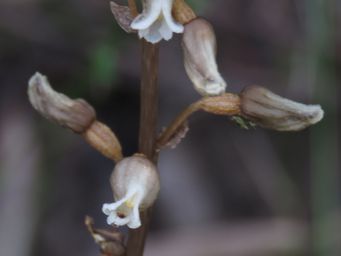
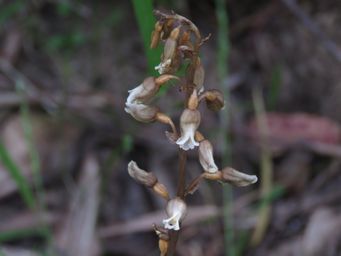
Gastrodia lacista, Potato Orchid, Western Potato orchid, Bell Orchid. (Some publications may call this Gastrodia sesamoides but that
is an eastern states species and a misnomer for the Western Australian species.)
Tubular orchid flowers grow up a stem up which may
reach half a metre and have up to fifty flowers. These are light tan on the outside and creamy white inside the bell-shaped flowers.
Without any foliage, Gastrodia are one of a group of plants that survive without making their own chlorophyll and are called mycotrophs
or mycotrophic plants. This means fungus feeder and refers to plants that parasitise soil fungi or bacteria to derive their sustenance.
December, seen here finishing flowering.
Northcliffe in the lower South West region, Western Australia, and can be found in
near coastal areas from near Margaret River to Albany and inland as far as Manjimup and Lake Muir, in the South West and lower Great
Southern regions, favouring areas with deep leaf and bark litter.
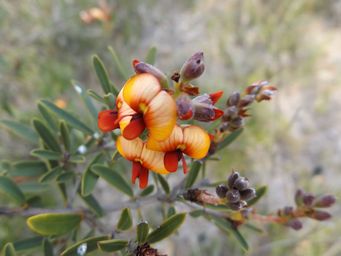
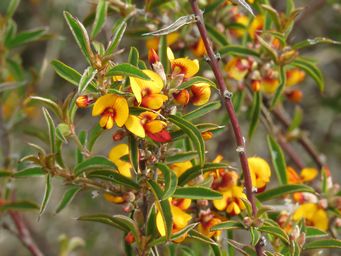
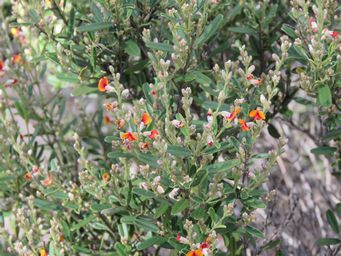
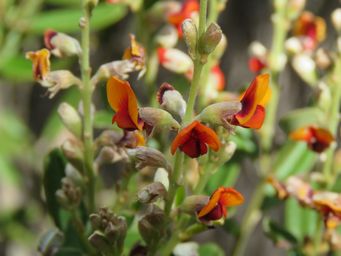
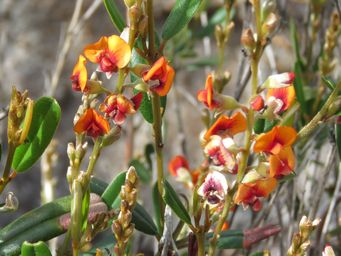
Gastrolobium obovatum 2002 (formerly Nemcia obovate), Boat-leaved Poison
Yellow pea flowers with red marks in centre, and red striping
of rear of petals. A short spindly bush with kite shaped leaves that are partially folded upwards. Leaves are opposite.
August
Goomalling, Wheatbelt region, Western Australia, and found principally through the Wheatbelt, reaching into the Mid West region
near Geraldton, and into the Goldfields near Ravensthorpe.












